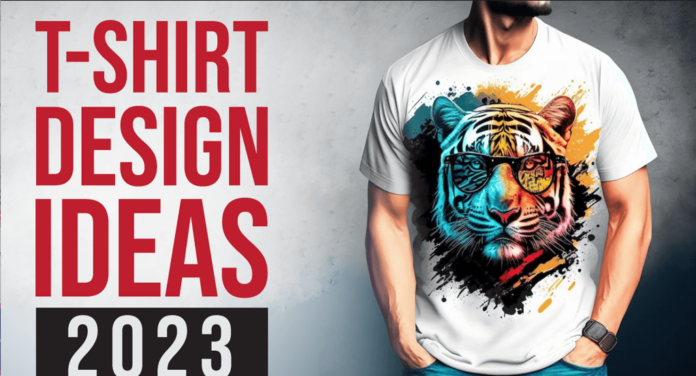From murals on walls to tattoos on skin, design, and branding have been instrumental in conveying messages, emotions, and identities. When applied to garments, especially t-shirts, the power of design can turn simple cloth into lucrative endeavors.
But how does one transform the ordinary into the extraordinary? Let’s embark on a journey, exploring the various facets of effective t-shirt marketing.
Creating Compelling Designs

When you step into the realm of garment design, artistry blends seamlessly with commerce. The key is to design graphics that resonate emotionally with consumers. One approach is to align with cultural or contemporary trends, making your tees timely and relevant. By aligning your design aesthetics with the zeitgeist, you tap into what people are currently feeling and thinking.
Tailoring your designs to specific target audiences further enhances their appeal. If your audience is tech-savvy young adults, consider incorporating QR codes or augmented reality elements into your t shirt printing designs. These tech elements not only captivate their attention but also ensure that the wearer engages with your brand in a unique way.
However, it’s equally crucial not to overlook the classic and evergreen designs. While trends change, certain icons, symbols, and motifs have a timeless appeal. By incorporating these into your tees, you ensure longevity and relevance across seasons and years.
Selecting High-Quality T-Shirt Materials
A great design can only go so far on subpar material. Fabric quality significantly influences the overall feel and durability of the t-shirt. Opting for soft, comfortable, and durable fabrics ensures your customers not only buy but also wear your t-shirts frequently.
Environmental consciousness is no longer an option—it’s a necessity. More consumers now prioritize eco-friendly products, even in apparel. So, consider investing in organic or sustainably sourced fabrics. Such a choice not only protects our planet but can also serve as a unique selling proposition for your brand.
Beyond environmental considerations, the finishing touches matter too. This means prioritizing aspects like stitch quality, fit, and wash durability. When these elements are on point, your t-shirts don’t just sell; they become wardrobe staples.
Pricing Your T-Shirts Strategically
Identifying the perfect price point is often a balancing act. Price your t-shirts too high, and you may deter potential customers; too low, and you risk undervaluing your brand. Begin by understanding your target audience’s purchasing power and preferences. Are they seeking luxury, or are they hunting bargains?
Once you have a ballpark figure, dissect your costs. Factor in material, production, marketing, and potential discounts. Pricing should cover these costs while ensuring profitability. Regular promotions or bundle deals can entice buyers without devaluing individual products.
Dynamic pricing is another avenue to explore. This involves adjusting prices based on demand, stock levels, or seasonality. By constantly optimizing, you can maximize both sales and revenue, ensuring that you’re always at the sweet spot in your pricing strategy.
Building an Engaging Online Presence

In today’s digital age, having a memorable online footprint is non-negotiable. Start by crafting an intuitive and visually appealing website. Seamless navigation, stunning visuals, and concise product descriptions can transform casual browsers into confirmed buyers.
Engage your visitors with compelling stories. Share the journey of your brand, the artisans behind each design, or the inspiration behind specific t-shirt collections. By humanizing your brand, you forge deeper connections with potential customers.
Feedback loops are essential. Encourage customer reviews, and display them prominently. Positive reviews build trust while addressing negative ones demonstrates commitment to customer satisfaction.
Effective Social Media Marketing
Harnessing the power of platforms like Instagram, Pinterest, or TikTok can significantly amplify your brand’s visibility. Begin by curating content that’s not only promotional but also educational or entertaining. Mixing product showcases with behind-the-scenes peeks can keep your audience engaged and invested.
Engagement goes two ways. Regularly interact with followers by responding to comments, sharing user-generated content, or hosting live sessions. This active participation fosters a community around your brand, making it more than just a business.
Lastly, don’t hesitate to invest in paid promotions. Algorithms often prioritize sponsored content, ensuring that your products land on the screens of potential buyers.
Utilizing Influencer Partnerships
Collaborating with influencers can supercharge your marketing efforts. Begin by identifying personalities whose followers align with your target audience. A match in values and aesthetics ensures authenticity, making collaborations more genuine.
Product seeding can be an excellent strategy. Gifting t-shirts allows influencers to organically integrate your products into their content. When their followers see them donning your designs, it adds credibility and desirability to your brand.
While organic collaborations are valuable, structured campaigns can further amplify reach. These might involve sponsored posts, co-designed collections, or even hosting events. When done right, these partnerships can create waves in the marketplace.
Optimizing E-commerce Platforms

An e-commerce platform is more than just a sales portal—it’s a digital representation of your brand. Streamline user experience by minimizing clicks, offering multiple payment options, and ensuring mobile optimization. A smooth, efficient checkout process can reduce cart abandonment rates.
Detailed product listings are paramount. Use high-quality images from various angles, provide precise sizing charts, and describe materials in detail. Such meticulousness reduces returns and fosters trust.
Lastly, integrate AI-powered chatbots or recommendation engines. These tools personalize shopping experiences, suggesting products based on browsing history or answering queries in real time.
Measuring and Analyzing Marketing Success
Metrics illuminate the path forward. Start by setting clear, measurable goals, whether they pertain to sales, website visits, or social media engagement. Tools like Google Analytics or Facebook Insights can offer detailed performance analyses.
Regularly evaluate campaigns to discern what works and what doesn’t. For instance, A/B testing different marketing strategies can help identify the most effective approaches. Continuous refinement based on feedback ensures you’re always on top of your game.
Beyond quantitative data, qualitative feedback is gold. Regularly survey customers or conduct focus groups. Such insights offer a richer understanding of customer preferences, desires, and pain points.
Final Thoughts
Embarking on a t-shirt marketing journey is akin to weaving a complex tapestry. Each thread, whether it’s design, pricing, or engagement, intertwines to create a holistic brand experience. By understanding and implementing these strategies, businesses can turn simple tees into lucrative endeavors. As you go forth, always remember, that the market is vast, but so is the potential. Every t-shirt tells a story; ensure yours is one worth wearing.








